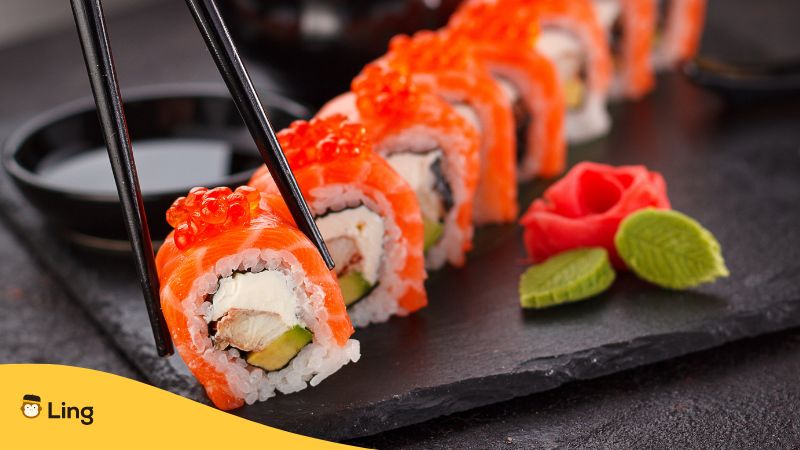Nothing screams Japanese than sushi, right? The word is synonymous to the Japanese culture across the world. This tiny, delicate piece of food item is a tangible representation of this island country like no other.
And if you’re planning to visit Japan, then learning how to eat sushi properly is a must. In this post, I’ll let you in on everything you need to know including translations in the Japanese language so you can really enjoy your experience. If you’re up for that (and more), read on below!
Table Of Contents
@takalovemari How many pieces of sushi can you eat in one sitting? 📍Kozushi, Nagano🇯🇵 #japan #sushi
♬ 真夜中のドア〜stay with me – 松原みき
What Is Sushi?
Sushi (すし) is a renowned Japanese dish that consists of vinegared rice combined with various other ingredients. The rice is first cooked and then seasoned with rice vinegar, sugar, and salt to give it a distinctive flavor and sticky texture. One of the most iconic components of sushi is nori, the edible seaweed sheets used for wrapping or garnishing rolls and hand-rolls.
A variety of fresh ingredients are used as toppings or fillings for sushi. Raw fish like tuna, yellowtail, salmon, and others are thinly sliced and served draped over compact ovals of vinegared rice. Seafoods like shrimp, crab, sea urchin roe, and more are also popular protein elements. For vegetarians, ingredients like cucumber, avocado, mushrooms, and other fresh vegetables are used.
How To Eat Sushi Properly
Following these proper sushi eating practices ensures you can fully savor and appreciate the fresh, delicate flavors and artful preparations that make sushi such a renowned Japanese culinary experience.
How Is Sushi Usually Eaten?
For nigiri sushi (oblong mounds with fish on top), pick it up with your hands and eat it upright to appreciate the perfect balance of fish, rice, and wasabi. Smaller sushi rolls can either be picked up with your hands and dipped into soy sauce before eating, or use chopsticks to pick up bite-sized pieces dipped in soy sauce.
Dipping Sushi In Soy Sauce
When dipping nigiri sushi into soy sauce, only dip the fish side briefly, not the rice side which will soak up too much soy sauce and become soggy. For sushi rolls, dip the end you’ll bite into first lightly into the soy sauce. Avoid over-soaking any sushi in soy sauce.

Applying Wasabi
For nigiri sushi, a dab of wasabi is typically already applied between the fish and rice by the sushi chef. For sushi rolls, you can add a small amount of wasabi directly to your soy sauce dish and mix it in before dipping the roll lightly.
Enjoying Sushi In One Bite
Nigiri sushi should be enjoyed in one bite to fully experience the harmony of flavors and textures the chef intended. Larger sushi rolls can be eaten in 2-3 bites at most, but not tiny bites, to still appreciate the balance.
Using Ginger As A Palate Cleanser
The thinly sliced pickled ginger (gari) is meant to refresh your palate between different types of sushi, not as a sushi topping itself. Eat a slice of ginger after finishing one type before moving to the next to reset your taste buds.
What Beverages To Pair With Your Sushi
You know, picking the right drink for your sushi really matters if you want the full experience. To make the most of it, be sure to order any of the following.
- Sake – The dry, crisp flavors of premium sake complement the delicate flavors of raw fish.
- Green Tea – Lightly brewed green tea, like a high-quality sencha or genmaicha, provides a refreshing, palate-cleansing accompaniment to sushi courses without overpowering flavors.
- Beer – Light, crisp lagers or Japanese rice-based beers are an excellent, thirst-quenching match for sushi’s mild tastes and provide a break from richer flavors.
- White Wine – Opt for a dry, light-bodied white like a Pinot Grigio or unoaked Chardonnay to avoid overwhelming the clean sushi tastes.
- Water – Never underestimate high-quality still or sparkling water to cleanse the palate between bites of different sushi varieties.
What Eat Along With Your Sushi
In addition to the various sushi itself, there are several traditional accompaniments that are typically served and consumed alongside sushi:
| English | Japanese Script | Romanized Japanese | Pronunciation |
|---|---|---|---|
| Edamame | 枝豆 | Edamame | |
| Oshinko (Pickled Vegetables) | お新香 or 漬け物 | Oshinko | |
| Miso Soup | 味噌汁 | Miso Shiru |
Types Of Sushi
Ready to take eat sushi? If yes, then you’ll be glad to know that there are several main types of it.
Nigiri Sushi – 握り寿司
This is an iconic sushi style consisting of an oval-shaped mound of vinegared rice with a topping draped over it, typically raw fish like tuna, salmon, or yellowtail. Nigiri is made piece by piece.
Maki Sushi – まき
Maki refers to cylindrical sushi rolls comprised of vinegared rice and various fillings wrapped up in dried seaweed (nori) sheets or soy paper. Common maki fillings include raw fish, cooked seafood, vegetables, and sometimes fruits.
Uramaki Sushi – うらまきずし
This is a special type of maki with rice on the outside and nori/fillings on the inside. Popular uramaki include the California roll.
Temaki Sushi – 手巻き
These are hand-rolled cone-shaped pieces with vinegared rice on the inside wrapped in nori with fillings spilling out.

Chirashi Sushi – 五目ちらし寿司
This is a bowl dish of vinegared rice topped with a variety of raw fish and other ingredients like fish roe and vegetables.
Inari Sushi – いなり寿司
These are pouches made of seasoned and fried tofu stuffed with vinegared sushi rice.
Oshizushi – おしずし
A pressed sushi formed by layering fish, vegetables, and seasonings on rice pressed in a wooden mold.
Sasa Sushi – 笹寿司
Unique to specific regions, this features sushi formed onto a skewer or bamboo leaf.
Common Ingredients In Sushi
While sushi is definitely an amazing food, some of you might be allergic to the ingredients. So when checking out the menu, please be sure to check the ingredients used based on the table below.
Japanese Phrases For Ordering Sushi
At some sushi places, particularly more casual spots, having basic Japanese skills enables ordering specialty items that may not be on the English menus. To help you out, here are some of the easiest phrases to get you started.
Ready To Start Eating Sushi?
To be honest, learning some Japanese before visiting can really level up your whole experience in Japan. Even just the basics – like greetings, polite phrases, being able to read signs and menus – it’ll help you get way more immersed in the local culture and vibe. You’ll have a little independence to get around, order food, and ask for help without having to rely fully on translations or tour guides holding your hand.
That’s where an educational platform like the Ling app can be a crutch. Since it’s on your phone, you can sneak in lessons anytime, anywhere – even on the road in Japan. The lessons with reading, listening, and visuals makes it an immersive way to actually learn. The best part? Ling covers cultural context too alongside language, so you really start to understand things better!
With portable, engaging features like that, Ling lets you lowkey get those survival Japanese skills down before your trip. Then you can just maximize all the authentic cultural experiences once you’re there instead of being lost in translation.































































